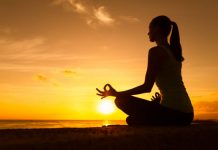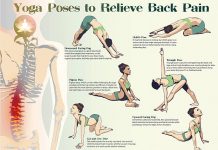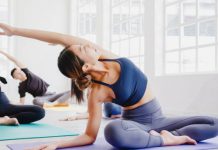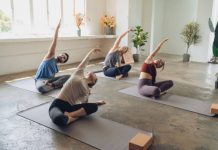Vinyasa yoga is a modern form of yoga that emphasizes flowing, fluid movement between asanas. It has several components, including Sun salutations, Ujjayi breathing, and linked movements with the breath. This article outlines the main characteristics of vinyasa yoga and how you can practice it.
Contents
Sun salutations
Sun salutations are an important part of Vinyasa yoga and are beneficial to many parts of the body. They provide a great cardiovascular workout, strengthen muscles and lubricate joints. They also promote deep breathing and improve brain circulation. The sun is also mentioned in an ancient scripture, a beautiful shloka.
Sun salutations can be difficult to perform for beginners, so make sure you practice them slowly and gently at first. This can help you avoid any injury or repetitive strain problems that may arise from doing the poses in the wrong sequence. The first step is to stand with your feet hip-width apart and take a deep breath.
There are many variations of Sun Salutations. Some have fewer poses, while others have longer, more challenging sequences that require more flexibility. You can also alter the Sun Salutations according to your specific needs. A beginner may choose to do fewer Sun Salutations, while an advanced practitioner will perform as many as nine or twelve.
Sun Salutations are important warmup exercises in Vinyasa yoga. They help tone and stretch the muscles and help relieve constipation. They also help speed up the metabolism and promote a balanced body. You can practice these sequences for about 15 minutes a day.
The Sun Salutations sequence begins with Mountain Pose at the front of the mat. This pose will align the body and bring the practitioner’s attention to the present moment. Throughout this sequence, the arms should be at the sides and palms facing forward. You may also use a hand gesture, called the Anjali Mudra, at the sternum.
Ujjayi breathing technique
Ujjayi breathing is a breathing technique that involves focusing on the center of the throat and creating a sound. The sound is very pleasant and easy to hear. It sounds like fogging up a pair of glasses. It is important to tone the throat before practicing this breathing technique.
This technique is useful for calming the mind and soothing the body. It is a very effective technique that can be practiced both on and off the mat. While performing a vinyasa yoga pose, yogis should aim to breathe in a slow, soft, deep, and long manner without tensing the throat muscles.
Ujjayi breathing is also known as the ocean breath and consists of three steps. The first part involves breathing in through the nostrils and the second is breathing out through the throat. The final part involves the diaphragm moving in an alternating fashion. This breathing technique helps to build heat within the body and is effective in meditation.
Movements linked together by the breath
Vinyasa yoga is a form of exercise that combines different movements linked together by the breath. These movements can be simple and straightforward, or they can be more advanced. Most classes incorporate several different postures. They may include twists, balancing poses, forward folds, inversions, and backbends. They usually build up to a peak pose.
In Vinyasa, you will usually see three to six movements in succession, and each movement is linked to a breath cycle. Breath inhalation is used to expand your belly and lengthen your spine, while exhalation is used to contract your abdominal muscles.
Vinyasa yoga can be a challenging practice and is often sweaty. The quick succession of the asanas increases heat in the body, which detoxifies the system and improves your cardiovascular health. Constant focus on breathing will also calm your mind and improve your focus.
Vinyasa yoga is designed to cater to various levels. Its powerful, flowing style is not as advanced as the traditional yoga, but it is perfect for beginners who are just starting out. A typical Vinyasa yoga class will start with a sun salutation, a flowing series of yoga poses, which warms the body and prepares it for the next posture.
Vinyasa is a style of yoga that celebrates the uniqueness of each person. It is a form of yoga that celebrates the mind, body, and spirit. Whether you are a beginner or an advanced practitioner, each vinyasa flow will challenge you and stretch your limits. It will strengthen your body and improve your range of motion, helping you become more flexible and limber.
Beginners should pay close attention to the instructions of the instructor during the practice. Beginners may find a vinyasa class confusing, but they should not feel hesitant to ask for help.
Class length
Vinyasa yoga classes typically feature a variety of postures, twists and balancing poses. Some classes also include backbends and inversions. Most classes build toward a peak pose at the end of the class. Because the tempo is so fast, vinyasa classes can be more intense than other forms of yoga.
Although a Vinyasa yoga class can seem intimidating at first, there are common patterns that most classes follow. A typical class will begin with a warm-up sequence and then move into standing or balancing postures. Think of it like a dance class, only with yoga poses.
A typical vinyasa yoga class lasts 45-60 minutes. The duration may vary from class to class depending on the instructor’s preference. Some advanced classes last two hours. Some classes are more interactive, while others focus more on technique. Regardless of the length of a Vinyasa class, you’re likely to gain a more effective practice.
A Vinyasa yoga class length should be adjusted to the experience of the students. A few minutes should be set aside for acclimating new students to the movements. After this, students should have enough time to breathe properly and begin stretching. They should also be given time to ease into the poses.
The length of a Vinyasa yoga class is determined by the teacher’s expertise and experience. The most knowledgeable teachers in this genre have spent years studying different poses and sequences. A Vinyasa yoga class can have anywhere from 15 to 50 students. Typically, the instructor will have at least two years of experience and have completed a 200-hour teaching training course.
The length of a Vinyasa yoga class varies, but is generally longer than the length of a traditional class. A traditional Vinyasa class moves through all the asana families in a single session. Some vinyasa classes feature more variation in the sequence, whereas others follow a strict set of asanas.
Benefits
Vinyasa yoga involves many poses that are linked together with the breath, and the sequences are usually quite challenging. However, there are modifications that are available for beginners who wish to improve their flexibility. These poses help to tone and strengthen muscles, and can even improve functional strength.
Vinyasa yoga focuses on finding balance and awareness of breath, and the key to a vinyasa yoga practice is to listen to your body and the instructor. Try not to force poses; you can end up injuring yourself. If you can’t do a pose correctly, the instructor will provide modifications. Once you’re stronger and more stable, you can try the original version of the pose.
Vinyasa yoga helps relieve stress and calms the mind. It has been proven to reduce anxiety, improve sleep, and decrease cholesterol levels. It helps the central nervous system by focusing on the breath. While practicing, you can also meditate and become more aware of your thoughts.
Vinyasa yoga also helps people with lower back pain. It increases mobility and reduces the risk of injury. It also improves overall circulation by allowing oxygenated blood to flow throughout the body. The practice also encourages better body awareness, which leads to fewer aches and pains.
Practicing yoga on a regular basis also helps you to control your emotions. Regular practice of yoga can help you to be more focused on your work and personal life. By focusing on the breath and transitions between asanas, you can control your emotions and become more efficient.




![[2023] Do Yoga With Me: Relieve Stress & Live Fully do yoga with me](https://seihive.com/wp-content/uploads/2022/09/istockphoto-1092303536-612x612-1-218x150.jpg)
![[2023] Yoga Origin – Its History & Philosophy yoga origin](https://seihive.com/wp-content/uploads/2022/09/istockphoto-1328501532-612x612-1-218x150.jpg)
![[2023] Kundalini Yoga for a Healthy Pregnancy kundalini yoga](https://seihive.com/wp-content/uploads/2022/09/istockphoto-904131880-612x612-1-218x150.jpg)



